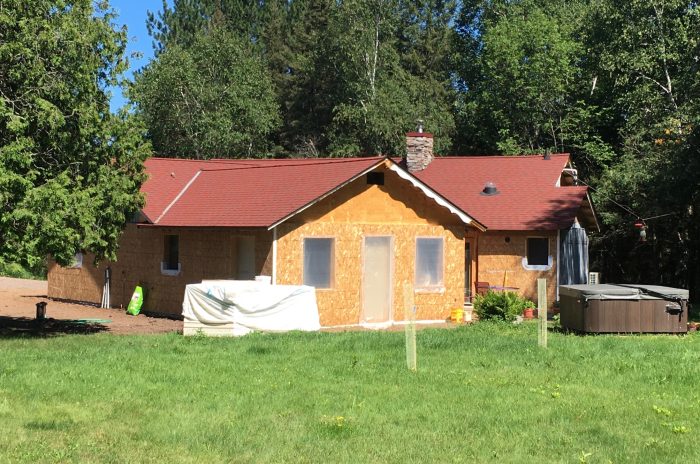
Here at Just Housing, we integrate nailbase panels into our assemblies because we like their flexibility when it comes to installing continuous insulation on both new construction and retrofit projects. Nailbase panels are rigid foam panels with a layer of OSB or plywood glued to one side; they provide sheathing and foam insulation in a single product. Here we will look at their application in a wall assembly, but nailbase panels can be used in roofs too.
New construction method
Our standard Just Housing wall demonstrates the application of nailbase panels in new construction. This assembly has 2×4 or 2×6 studs with structural plywood sheathing sealed as the air barrier. The plywood is then wrapped with a layer of nailbase panels. We design the drainage plane to the outside of the nailbase panels and specify a water-resistive barrier (WRB) sheet good installed shingle style, integrated with window, door, and base flashings.
Real-world retrofit
For retrofits where new siding is planned, nailbase panels work well for installing continuous insulation, and they can be integrated whether or not the windows are replaced. That said, it is critical to ensure the new nailbase panel is compatible with the rest of the existing assembly.

The retrofit project pictured here benefitted from the use of nailbase panels. The owners were uncomfortable in their leaky, underinsulated 1960s ranch home, and their energy bills were high, but they loved their house and its location. They—and the house—were ready for some improvements.
The existing wall assembly included 2×6 studs sheathed with T1-11 plywood; installation was too close to grade, which resulted in rotting structural wood. Conditions included a former attached garage that had been converted to living space; it was insulated with closed-cell spray foam. The rest of the house had poorly installed fiberglass insulation. The presence of…
Weekly Newsletter
Get building science and energy efficiency advice, plus special offers, in your inbox.

This article is only available to GBA Prime Members
Sign up for a free trial and get instant access to this article as well as GBA’s complete library of premium articles and construction details.
Start Free TrialAlready a member? Log in














10 Comments
Good ideas. I would love to see wood fiber nailbase!
When it comes to moisture-related concerns, I use the most conservative values for foam insulation. We know that eventually, all closed-cell foam products, including polyiso, will have the blowing agents in the cells replaced with air, which is R-5.6/in, and we know that polyiso performs worse at low temperatures, which is a dynamic value and impossible to pin down, but I would not over-estimate the R-value because even if it works well today, eventually--whether 10 years or 30 years--it won't perform the same way.
Conversely, when it comes to meeting code-required thermal envelope values with foam, which has high levels of embodied carbon emissions, I use the highest R per inch published.
Nice to hear from you, Michael! Like you, we adjust the R-value per inch in response to whether it's performance analysis vs required documentation to meet code requirements ... we couldn't figure out how to write that into the article, so thanks for bringing it up. And yes, we also hope to see wood fiber nailbase products on the market.
Some of the Neopor / GPS products approach RSSi 5.4 around 25F. Interesting chemistry with putting Graphene into the mix. Will need to apply some wax to a nail base panel and slide down Spirit Mountain to test the friction coefficient. :)
All common types of insulation perform better at low temperatures than at high temperatures, with the exception of polyiso foam. R-value is measured at mean 75°F.
Good article. What are some if the manufacturers and dealers for these panels in new england? What is the pricing range? Thanks
We're located in Minnesota, so I can't speak to dealers in New England, and I don't know a lot about manufacturers in your region. The companies I'm most familiar with who manufacture nailbase panels are Hunter, Atlas, Insulfoam, Porter Corp, and Huber. Hunter is headquartered in Maine and does have a manufacturing facility in the state. Hope that helps.
“[Deleted]”
I'm curious what others think about fastener conductivity (thermal bridging) through the nail base insulation. By my calcs, one fastener per SF (Atlas recommends between 15–50 per 4'x8' sheet) has the same conductivity as the remaining SF of EPS. So practically, an R-6 sheet is adding R-3.
Steve,
https://sustainableengineering.co.nz/assessing-the-thermal-impact-of-conductive-fasteners/
I’ve always wondered about about how the fasteners affect thermal bridging. On our ongoing home reno I’ve been adding 3”of XPS to the exterior.
The framing is 16” oc with 1/2 or 5/8 ply fitted tight between, edges glued and pocket screws from exterior around the edge ( I acquired a huge amount of waste ply that was well suited for this).
Then 5/8 ply applied as sheathing, glued to studs and ply infill
3” of XPS followed by 5/8” Zip.
The Zip is screwed to the studs using 1/4” spax washer head screws, in the field with 6” GRK screws which bite well into the 2 layers of ply.
On the exterior I cut squares of zip tape and apply to every screw head. On the interior I cut off any extra screw sticking thru the ply (leaving approx 1/32 proud), then apply a smear of 4200 or 5200 to the cut of screw shank. Intent is to reduce the potential of condensation on exposed metal in stud cavity (I work in a boatyard and waste tubes of useable 4200/5200 are prevelant, no need to pay for or let it go to waste). Stud cavities are insulated with roxul and have a Santa Fe dehu running in basement to things below 50.
Log in or become a member to post a comment.
Sign up Log in